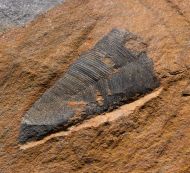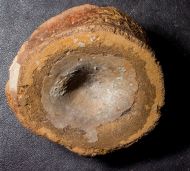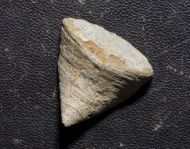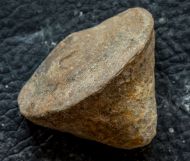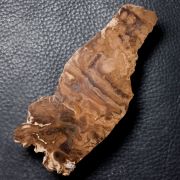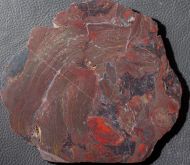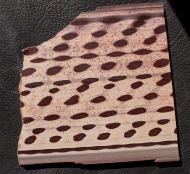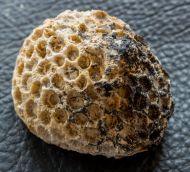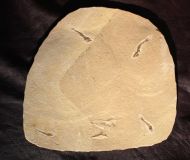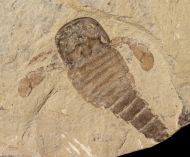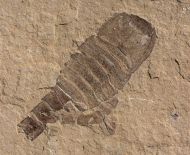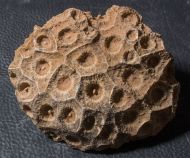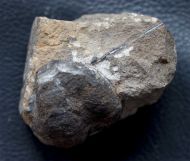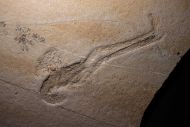Fossils for sale
Welcome back!
Other Fossils from all over the World
More sub categories:
Here is a very nice preserved Conularia from the upper Ordovician of the Tafilalt in Morocco. Conulariids are relative rare fossils even they are geographically wide distributed. This specimen shows a striking similairety to Archaeoconularia consobrina, that is known from the Ordovician of the Czech Republic.
Shipping time: 3-4 Days
46,95 EUR
7 % VAT incl.
This is a nice and large Ichthyosaurus vertebra fossil of the Genus Brachypterigus from the late Jurassic.
It is most likely belong to the speces Brachpterygius extremus Boulenger 1904.
It is most likely belong to the speces Brachpterygius extremus Boulenger 1904.
Shipping time: 3-4 Days
48,95 EUR
7 % VAT incl.
Here is a Rugosa Coral of the species Calceola sandalina from the Eifilian of the Eifel Mts. This large specimen shows the cover what is quite rare the case on Calceola sandalina.
Shipping time: 3-4 Days
7,95 EUR
7 % VAT incl.
Here is a Rugosa Coral of the species Calceola sandalina from the Eifilian of the Eifel Mts. This large specimen shows the cover what is quite rare the case on Calceola sandalina.
Shipping time: 3-4 Days
6,95 EUR
7 % VAT incl.
This is a large fossil bivalve of the species Camptonectus cinctus from the lower Cretaceous of Hollwede.
Shipping time: 3-4 Days
12,95 EUR
7 % VAT incl.
This is a nice and large Bivalve of the species Camptonectus cinctus from the lower Cretaceous of Hollwede. The Bilavle is complete preserved with both Clam sides.
Shipping time: 3-4 Days
29,95 EUR
7 % VAT incl.
Here is a large Bivalve of the species Camptonectus cinctus from the lower Cretaceous of Hollwede.
Shipping time: 3-4 Days
26,95 EUR
7 % VAT incl.
Here is a nice cut of a fossil stromatolite of the species Chlorellopsis coloniata from the Green River Formation.
Shipping time: 3-4 Days
39,95 EUR
7 % VAT incl.
Here is a very nice Stromatolite plate from the deep Precambrian of the USA,
Es is a polished slap with the speices Collenia undosa from the about 2.2 Billion years old Biwabik-Iron-Formation of Minnesota.
Es is a polished slap with the speices Collenia undosa from the about 2.2 Billion years old Biwabik-Iron-Formation of Minnesota.
Shipping time: 3-4 Days
135,00 EUR
7 % VAT incl.
This is a rare and interesting sediment fossil from the Ediacaran period, classified as Cupperia tubiformis.
Shipping time: 3-4 Days
240,00 EUR
7 % VAT incl.
This is a nice Nattheim Coral of the Genus Cyathophora.
Shipping time: 3-4 Days
29,95 EUR
7 % VAT incl.
This is a attractive plate with four fossil fish of the species Dastilbe elongatus from the lower cretaceous of Brazil.
Shipping time: 3-4 Days
39,95 EUR
7 % VAT incl.
Here is a decorative fossil of a Coral Colony of the genus Disphyllum from the Devonian of Payson, Arizona.
Shipping time: 3-4 Days
29,95 EUR
7 % VAT incl.
Here is a nice plate with several good Eurypterus specimens of the species Balteurypterus tetragonophtalmus from the Silurian of Ukraine. The small specimen with the beautifully preserved chelicerae is about 26 mm long.
Shipping time: 3-4 Days
175,00 EUR
7 % VAT incl.
This fossil sea scorpion is an inexpensive specimen of a Eurypterus from the Silurian of Ukraine.
Shipping time: 3-4 Days
39,95 EUR
7 % VAT incl.
This is a beautifully preserved and finely detailed eurypterid of the species Balteurypterus tetragonophthalmus, originating from the Silurian deposits of Ukraine.
Shipping time: 3-4 Days
220,00 EUR
7 % VAT incl.
This is an inexpensive Eurypterus of the species Balteurypterus tetragonophtalmus from the Silurian of Ukraine.
Shipping time: 3-4 Days
75,00 EUR
7 % VAT incl.
Here is a beautiful fossil coral colony of the species Hexagonaria hexagona from the Middle Devonian of Bou Tchrafine in Morocco.
Shipping time: 3-4 Days
29,95 EUR
7 % VAT incl.
Here is an inexpensive example of a fossil brachiopod that belongs to the species Horridonia horrida from the Upper Permian.
Shipping time: 3-4 Days
6,95 EUR
7 % VAT incl.
Here is a good long-arm lobster of the species Mecochirus longimanatus from the Solnhofen limestone of Eichstätt. On or above its carapace is a small fossil sponge of the genus Codites.
Shipping time: 3-4 Days
90,00 EUR
7 % VAT incl.













